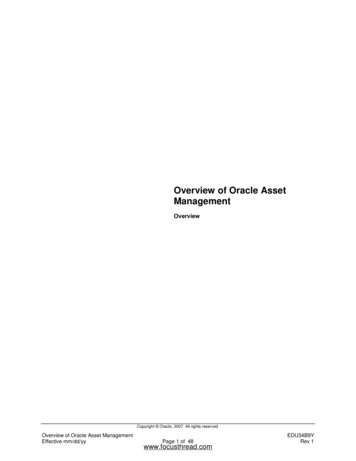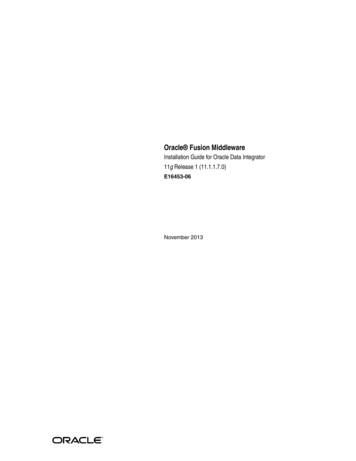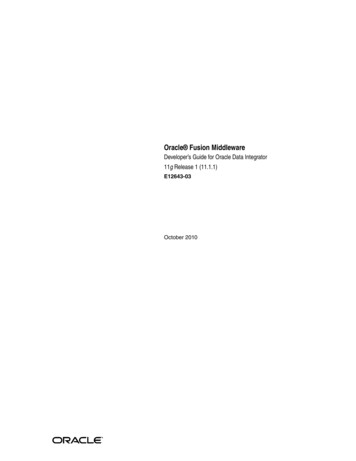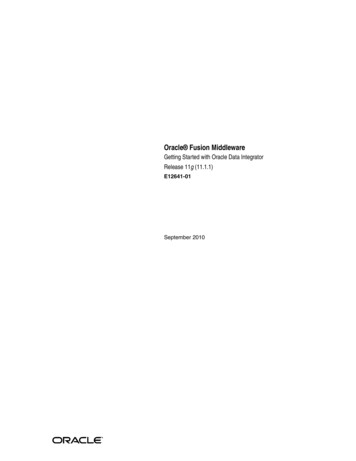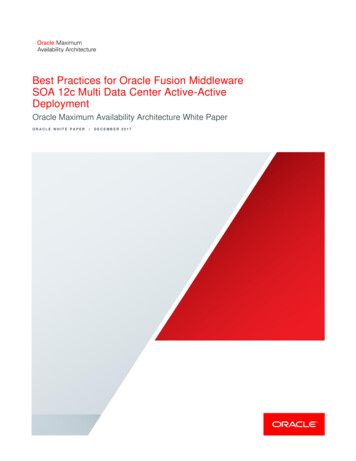
Transcription
Best Practices for Oracle Fusion MiddlewareSOA 12c Multi Data Center Active-ActiveDeploymentOracle Maximum Availability Architecture White PaperORACLE WHITE PAPER DECEMBER 2017
ContentsParadigms for Designing a Multi Data Center Active-Active Deployment for OracleFusion Middleware SOA5Availability: RTO and RPO5Performance6Administration6Latency, Jitter, Packet Loss and Bandwidth Across Sites7Requirements15Topology15Network15Shared Storage vs. Database for Transaction Logs and Persistent stores15Load Balancers15Oracle Fusion Middleware SOA Components and Versions in Scope15Hardware Resources and Capacity Utilization16Topology Model for an Oracle Fusion Middleware SOA Active-Active Multi Data CenterDeployment17Database Tier17Load Balancers and Web Servers18Application Layer19Characteristics of the DesignOther ResourcesConfiguring the Oracle Fusion Middleware SOA Active-Active Topology1 BEST PRACTICES FOR ORACLE FUSION MIDDLEWARE SOA 12C MULTI DATA CENTER ACTIVE-ACTIVE DEPLOYMENT212324
Configuring Load Balancers and Global Load Balancers for Oracle FusionMiddleware SOA Multi Data Center Active-Active Deployment24Configuring Oracle HTTP Server for Oracle Fusion Middleware SOA Multi DataCenter Active-Active Deployment26Configuring the Application Tier of an Oracle Fusion Middleware SOA AA DRSystem for a Stretched Cluster27Configuring Data Sources for Oracle Fusion Middleware SOA Multi Data CenterActive-Active Deployment36Composite and MDS Deployments and Updates: Oracle Coherence Configuration38In-memory soa42Setting Appropriate Timeouts for Synchronous and Asynchronous Operations43Session Replication Implications46Optimizing Oracle Net Services Performance47Configuring I/O Buffer Size in the Database Server48Configuring I/O Buffer Size on the Oracle Fusion Middleware Nodes48Configuring Session Data Unit49Failures in Different Tiers and Switchover/Failover Behavior52Failure in All OHS Instances in One Site52Failure in All Oracle WebLogic Server SOA Servers in One Site52Administration Server Failure52Database Failures: Data Guard Switchover and Failover54Performance and Scalability Implications for an Oracle Fusion Middleware SOA MultiData Center Active-Active Deployment2 BEST PRACTICES FOR ORACLE FUSION MIDDLEWARE SOA 12C MULTI DATA CENTER ACTIVE-ACTIVE DEPLOYMENT55
Capacity Usage and Planning55Start Latencies56Average Active Time for Transactions and Transaction Recovery59Summary61Appendix A: File Adapter Locks and Muxers62Appendix B: Configuring in-place restart for JMS JDBC persistent stores63Appendix D: Oracle Service Bus Considerations66Load balancer considerations66Application Tier considerations66OSB Performance in a Stretched Cluster67References3 BEST PRACTICES FOR ORACLE FUSION MIDDLEWARE SOA 12C MULTI DATA CENTER ACTIVE-ACTIVE DEPLOYMENT73
IntroductionBusiness continuity is a key requirement for many e-business operations. Downtime of mission-criticalapplications translates directly into reduction in productivity, service quality, and lost revenue. Missioncritical application services require both a local high availability solution and a disaster recoverysolution. A local high availability solution provides redundancy in one data center. Additionally,applications need protection from unforeseen disasters, natural calamities, and downtime that canaffect an entire data center. An effective disaster that disables an application service is not necessarilyone that destroys the whole data center (e.g. flood, fire), but is more likely to disable one particulartype of resource. For example, a failure of corporate gateways or ISP network connections, a spreadof viruses to all HTTP listener nodes, a miss configuration, a power outage, or an incorrect patch couldall lead to days of complete loss of services. The same applies to planned outages: a networkinfrastructure update, a firewall upgrade, etc. may have similar downtime effects in a datacenter. In aService Oriented Architecture (SOA) multiple corporate systems may depend on a unique serviceprovider. As the adoption of these architectures grows, so does the need for failure and downtimeprotection not only in the scope of a single machine, but also against events that may bring down agroup of machines, an entire room or an entire building. Traditional disaster protection systems use amodel where one site is running while another site is on standby in prevention of possible failoverscenarios (also called Multi Data Center Active-Passive or Active-Passive Disaster Protection). Suchapproaches usually incur increased operational and administration costs, while the need forcontinuous use of resources and increased throughput (i.e. avoiding situations where the standbymachines are idle) have increased through the years. IT systems’ design is increasingly driven bycapacity utilization and even distribution of load, which leads to the adoption of disaster protectionsolutions that use, as much as possible, all resources available (called Multi Data Center Active-Activeor Active-Active Disaster Protection).This paper describes the recommended Active-Active solutions that can be used for protecting anOracle Fusion Middleware 12c SOA system against downtime across multiple locations (referred to asSOA Active-Active Disaster Recovery Solution or SOA Multi Data Center Active-Active Deployment) Itprovides the required configuration steps for setting up the recommended topologies and guidanceabout the performance and failover implications of such a configuration.4 BEST PRACTICES FOR ORACLE FUSION MIDDLEWARE SOA 12C MULTI DATA CENTER ACTIVE-ACTIVE DEPLOYMENT
Paradigms for Designing a Multi Data Center Active-Active Deployment for OracleFusion Middleware SOAThere are multiple factors that can drive the design of a Multi Data Center Deployment. The following are usuallyconsidered:Availability: RTO and RPODisaster Recovery designs need to minimize the Recovery Point Objective (RPO) and the Recovery Time Objective(RTO) metrics. RPO measures the amount of data that can be lost in the event of a failure while RTO measures thetime the system will be unavailable should a failure occur.In most Multi Data Center Active-Active Deployments or Active-Active Disaster Recovery systems the reality is thatthe database tier is usually active in only one site. There are alternatives to this approach (Oracle Real ApplicationClusters on Extended Distance Clusters, Cross-Site Caching (Oracle GoldenGate), and database replication(Streams)) however these solutions are either very demanding in terms of infrastructure required or require specificdata types and rules with which not all applications are compliant.The main advantage of a Multi Data Center Active-Active Deployment system as compared to traditional Multi DataCenter Active-Passive Disaster Recovery design is that in the event of complete middle tier failure in one site (allmiddle tier servers in one location), the system can fulfill requests because there are middle tiers in the peer site thatremain available. In other words, RTO and RPO for Multi Datacenter Active-Active Deployments are null in this typeof scenario. For this, the middle tier servers in the alternative location need to be able to sustain the combined loadof all locations. The appropriate capacity planning must be done to account for such scenarios. Depending on thedesign, requests from end clients may need to be throttled when only one site is active. Otherwise, sites must bedesigned with exceeding power, hence partially defeating the purpose of constant and efficient capacity usage.When a failure occurs in the database tier, both Multi Data Center Deployment Active-Active and Multi Data CenterActive-Passive present similar RTO and RPO since the database is the driver for recovery and in both cases it isactive only in one site and passive in the other. The only advantage of Multi Data Center Active-Active Deploymentsystems is that an appropriate Data Source configuration can automate the failover of database connections fromthe middle tiers, reducing RTO (the recovery time is decreased because restart of the middle tiers is not required)1.1 The Oracle WebLogic Servers may need to be restarted depending on different aspects. When using database leasing, Oracle WebLogic Servers mayshut down if the database remains unavailable (during switchover or failover).5 BEST PRACTICES FOR ORACLE FUSION MIDDLEWARE SOA 12C MULTI DATA CENTER ACTIVE-ACTIVE DEPLOYMENT
PerformanceBesides the common performance paradigms that apply to single-datacenter designs, Oracle Fusion MiddlewareSOA Multi Data Center Active-Active systems need to minimize the traffic across sites to reduce the effect of latencyon the system’s throughput. In a typical Oracle Fusion Middleware SOA System, besides database access (fordehydration, metadata access, and other database read/write operations that custom services that participate in thesystem may perform), communication between the different tiers can occur mainly over the following protocols:» Incoming HTTP invocations from Load Balancers (LBR) or Oracle HTTP Servers (OHS) and HTTP callbacks» JNDI/RMI and JMS invocations between Oracle WebLogic Servers» Read/write requests to file systems for file/FTP adaptersFor improved performance, all of the above should be restrained, as much as possible, to one single site. That is,servers in SiteN ideally should just receive invocations from Oracle HTTP Servers in SiteN. They should make JMS,RMI and JNDI invocations only to servers in SiteN and should get callbacks generated by servers only in SiteX.Additionally, servers should use storage devices that are local to their site to eliminate contention (latency for NFSwrites across sites may cause severe performance degradation).There are additional types of invocations that may take place between the different SOA servers that participate inthe topology:» Oracle Coherence notifications: Oracle Coherence notifications need to reach all servers in the system toprovide a consistent composite and metadata image to all SOA requests, whether served by one site or theother.» HTTP session replications: some Oracle Fusion Middleware SOA components use stateful webapplications (such as Composer, Workspace, etc.) that may rely on session replication to enable transparentfailover of sessions across servers. Depending on the usage patterns and number of users this maygenerate a considerable amount of replication data. Replication and failover requirements have to beanalyzed for each business case, but ideally session replication traffic should be reduced across sites asmuch as possible.» LDAP/policy/identity store access: Access to policy and identity stores is performed by Oracle WebLogicServer infrastructure and SOA components for authorization and authentication purposes. In order to enableseamless access to users from either site, a common policy or identity store view needs to be used. Ideallyeach site should have an independent identity and policy store that is synchronized regularly to minimizeinvocations from one site to the other. Alternatively, both sites can share the same store. The impact ofsharing the store will depend on the type of store and the usage pattern by the SOA system.AdministrationAnother key aspect of the design and deployment of an Oracle Fusion Middleware SOA Multi Data CenterDeployment is the administration overhead introduced by the solution. In order to keep a consistent reply torequests, the sites involved should use a configuration such that the functional behavior of the system is the sameirrespective of which site is processing those requests. Oracle Fusion Middleware SOA keeps its configuration andmetadata in the Oracle database. It is for this reason that Multi Data Center Active-Active Deployments with aunique active database guarantee consistent behavior at the composite and metadata level (there is a single sourceof truth for the involved artifacts). The Oracle WebLogic Server configuration, however, is kept synchronized acrossmultiple nodes in the same domain by the Oracle WebLogic Server infrastructure. Most of this configuration usuallyresides under the Administration Server’s domain directory. This configuration is propagated automatically to theother nodes in the same domain that contain Oracle WebLogic Servers. Based on this, the administration overhead6 BEST PRACTICES FOR ORACLE FUSION MIDDLEWARE SOA 12C MULTI DATA CENTER ACTIVE-ACTIVE DEPLOYMENT
of a Multi Data Center Active-Active Deployment system is very small as compared to any active-passive approachwhere constant replication of configuration changes is required.Latency, Jitter, Packet Loss and Bandwidth Across SitesThe overall network throughput of an Oracle Fusion Middleware SOA Multi Data Center Active-Active Deploymentsystem is primarily driven by two factors: the length of the route that the requests have to take between the differentsites (mainly for database access) and the interaction between the TCP reliability and congestion control protocols.Regardless of the speed of the processors where Oracle Fusion Middleware SOA runs or the efficiency of thesoftware, it takes a finite amount of time to manipulate and “present” data from one site to the other. Two importantmeasurements of time intervals in network transmission systems are referred to as latency and jitter. Networklatency is the amount of time it takes for a packet to be transmitted end-to-end across a network, and it is composedof multiple variables (the type and number of switches between sites, the type of cabling, etc.) Latency in a networkis measured either one-way (the time from the source sending a packet to the destination receiving it), or round-trip(the one-way latency from source to destination plus the one-way latency from the destination back to the source).Round-trip-time (RTT) latency is used more frequently because it provides a more realistic figure of the delay(accounts for traffic in both directions) and can be measured with the ping utility in most systems. Jitter is a term thatrefers to the variance in the arrival rate of packets from the same data flow. Both latency and jitter have a negativeimpact on applications with communications across sites. They are critical for the appropriate behavior of an OracleFusion Middleware SOA Multi Data Center Active-Active Deployment. Jitter, however, is typically more relevant insystems with extremely low latency. Thus, latency is effectively the main aspect that must be controlled in a MultiData Center Active-Active Deployment. The main causes of latency are:» propagation/distance delay» serialization» data protocols» routing and switching» queuing and bufferingOf all of the above causes, distance delay is typically the most relevant one. Distance delay is the minimum amountof time that it takes the electrical signals that represent bits to travel on a physical wire. Optical cable sends bits atabout 5.5 µs/km, copper cable sends it at 5.606 µs/km, and satellite sends bits at 3.3 µs/km. Distance delay canhave a significant impact on the performance of an Oracle Fusion Middleware SOA Multi Data Center Active-ActiveDeployment because multiple network round trips (mainly from the Oracle Fusion Middleware SOA servers to theSOA database) are required to complete each composite instance. Tests conducted have shown that an OracleFusion Middleware SOA Multi Data Center Active-Active Deployment’s performance (where Oracle WebLogicServer SOA servers use a database in a different site) degrades considerably when latency exceeds 5-10milliseconds. The graphs in Image 1 and Image 2 show the throughput (transactions per second) and averagetransaction active time for a Fusion Order Demo (FOD) Oracle Fusion Middleware SOA system that uses adatabase on a different site with different latencies between sites:7 BEST PRACTICES FOR ORACLE FUSION MIDDLEWARE SOA 12C MULTI DATA CENTER ACTIVE-ACTIVE DEPLOYMENT
Site 2 TX Throughput vs. Latency (RTT in 214161820Latency between sites (RTT in ms)Image 1: Evolution of throughput with different latencies (RTT in msecs.) between sites (FOD)Throughput degradation (%) with latency (RTT in ms)% WLS Througput degradation12010080604020012571020RTT (ms)Image 2: Evolution of the time that a transaction remains active as the latency (RTT in msecs.) between the SOA servers and thedatabase is increased8 BEST PRACTICES FOR ORACLE FUSION MIDDLEWARE SOA 12C MULTI DATA CENTER ACTIVE-ACTIVE DEPLOYMENT
Image 3 shows the degradation observed in the overall system’s throughput (both sites working together) fordifferent latencies. Observe that for a latency of around 20 milliseconds RTT the thoughput decreases almost 25%.Site 2 Avg. TX Active Time vs. Latency (RTT in ms)0,45Avg. TX active time 14161820RTT (ms)Image 3: Throughput degradation for different latencies (RTT in msecs.)Image 4 shows the degradation in total transactions/sec processed by the system (both sites working together) fordifferent latencies. Observe that for a latency of 20 milliseconds RTT the TX/sec throughput decreases almost 25%.9 BEST PRACTICES FOR ORACLE FUSION MIDDLEWARE SOA 12C MULTI DATA CENTER ACTIVE-ACTIVE DEPLOYMENT
Overall TX/sec degradation (%) with latency (RTT)120100% TX/sec80604020012571020RTT between sites (ms)Image 4 Overall TX/sec degradation for different latencies (RTT in msecs)Image 5 shows the overall JMS/sec thoughput degradation for the system (both sites working together) for differentlatencies between sites (RTT in miliseconds). For latencies of 20 ms (RTT) the JMS throughput decreases morethan 25%.10 BEST PRACTICES FOR ORACLE FUSION MIDDLEWARE SOA 12C MULTI DATA CENTER ACTIVE-ACTIVE DEPLOYMENT
Overall JMS messages/sec degradation (%) with latency(RTT)120% JMS messages/sec10080604020012571020RTT between sites (ms)Image 5 Overall JMS messages/sec degradation for different latencies (RTT in ms) between sitesImage 6 shows the degradation in total transactions/sec processed by Site2 only (when both sites working together)for different latencies between sites, compared with the transactions/sec processed by Site1 servers during thesame test. Observe that for a latency of 20 milliseconds (RTT) the transaction throughput in Site2 decreases about35%.11 BEST PRACTICES FOR ORACLE FUSION MIDDLEWARE SOA 12C MULTI DATA CENTER ACTIVE-ACTIVE DEPLOYMENT
Site 2 TX/sec degradation (%) with latency between sites (RTT)120100% TX/sec8060402001257RTT between sites (ms)1020Image 6 Site2 TX/sec degradation compared with the TX/sec procesed by Site1 servers during the same test, for different lateciesbetween sites (RTT)The following image shows the total number of active connections for a server in Site1 and a server in Site for theSOA datasource during an stress load, for different latencies between sites (RTT in milliseconds). Note that for aserver in Site2, there are more active connections in the datasource because they are active during more time, andthe number is increased with the latency between the servers and the database. This increment must be taken inaccount when tuning the size of the datasource, than may need to be adjusted for high latencies,and has an effect also in recovery times for a site 2 server when a failure occurs in the database: more connectionsneed to be recreated and more number of transactions need to be recovered.12 BEST PRACTICES FOR ORACLE FUSION MIDDLEWARE SOA 12C MULTI DATA CENTER ACTIVE-ACTIVE DEPLOYMENT
Avg. SOADS active connections per Server vs. RTTAvg. SOADS active connectionsper 5101520RTT (ms)Image 7 Average SOA Data Source active connections during a load test for a server in Site1 and a for a server in Site2Image 8 shows the increase in time taken to deploy a composite in a Site2 server compared to the the time taken todeploy in a Site1 server (SOA server and database in the same site). The time is higher in the servers of Site2 dueto the higher latency to the database. When deploying a composite (first version or updates to newer versions) in thea Multi Data Center Deployment the composite may be deployed earlier in Site1 servers than in Site2 servers,although it is not activated until is is available in all members of the cluster. Refer to “Composite and MDSDeployments and Updates: Oracle Coherence Configuration” section for more details.Additional Deployment TimeAdditional Deployment time (ms) vs Latency (RTT)2000015000100005000002468101214161820RTT (ms)Image 8: Additional time (msecs) consumed for deploying composites with increasing latencies (RTT in msecs.) when the SOAdatabase resides on a different site13 BEST PRACTICES FOR ORACLE FUSION MIDDLEWARE SOA 12C MULTI DATA CENTER ACTIVE-ACTIVE DEPLOYMENT
When Oracle Data Guard is configured between the two sites, the effect of the latency between sites in thedatabase performance depends on the Data Guard protection mode used. Oracle Data Guard can be configured inMaximum Availability, Maximum Performance, or Maximum Protection mode. When it is configured for MaximumPerformance (default), redo data is written to the standby database asynchronously with respect to transactioncommitment, so primary database performance is unaffected by the time required to transmit redo data and receivethe acknowledge from a standby database. This protection mode offers slightly less data protection than maximumavailability mode and has minimal impact on primary database performance.When Data Guard is configured for Maximum Availability or Maximum Protection, the transactions do not commituntil all redo data needed to recover those transactions has been received by the standby database. This protectionmode provide higher level of data protection but the effect in the performance is higher.Note that the effect of latency is orthogonal to the bandwidth between two sites (that is, it will affect equally large orsmall messages and payloads). For example: if a SOA server executes a SQL database query that requests 100rows of the CUBE INSTANCE, MEDIATOR INSTANCE and DLV MESSAGES tables, one row at a time, over alink with a latency of 60 ms, it takes approximately 6 seconds (60 ms * 100 turns) to complete the transactionindependently of the amount of data in each row. The same query executed by a user on a LAN connected to thesame database server takes less than 2-3 ms to be completed, as the latency due to distance across the LAN isinsignificant. This is irrespective of the size of each row. Bigger rows can be retrieved with better bandwidth, but theoverall transaction takes the same amount of time.With all of the above in mind and provided the performance penalties observed in many tests, Oracle recommendsnot to exceed 10 msecs of latency (RTT) for SOA Multi Data Center Active-Active systems when the latencyaffects database communications. Systems may operate without issues, but the transaction times will increaseconsiderably. Latencies beyond 10 msecs (RTT) will also cause problems in the Coherence cluster used fordeployment and JTA and web services timeouts for most common composites. This makes the solutions presentedin this paper suitable primarily for Metropolitan Area Networks with low latency between sites (for example, thedistance from San Francisco to Boston is around 4330 kms and typical latencies are approximately 30-40 msecs).14 BEST PRACTICES FOR ORACLE FUSION MIDDLEWARE SOA 12C MULTI DATA CENTER ACTIVE-ACTIVE DEPLOYMENT
RequirementsTopologyThe analysis and recommendations included in this paper are based on the topology described in the “TopologyModel for an Oracle Fusion Middleware SOA Active-Active Multi Data Center Deployment” section. Each site locallyuses an Oracle Fusion Middleware SOA Enterprise Deployment Topology (separation of WSM-PM servers, sharedstorage and directory structure, etc.). The system requirements are those specified in the Oracle Fusion MiddlewareEnterprise Deployment Guide for Oracle SOA Suite.Additionally, the following requisites must be met:NetworkLatency between the two sites used in the design should not be higher than 10 msecs RTT. The bandwidthrequirements will vary based on the type of payloads used by each SOA system.Shared Storage vs. Database for Transaction Logs and Persistent storesThe topology addressed in this paper was tested using database-based persistent stores for Oracle WebLogicServer transactions logs and Oracle WebLogic Server JMS persistent stores. Storing transaction logs and persistentstores in the database provides the replication and high availability benefits inherent from the underlying databasesystem. With JMS, TLOG, and SOA data in a Data Guard database, cross-site synchronization is simplified and theneed for a shared storage sub-system such as a NAS or a SAN is alleviated in the middle tier (they still apply for theAdministration Server’s failover, deployment plans, and some adapters like File Adapter). Using TLOGs and JMS inthe database has a penalty, however, on the system’s performance. This penalty is increased when one of the sitesneeds to cross communicate with the database on the other site. This penalty applies also to JMS Servers that useAQ destinations. From a performance perspective, a shared storage that is local to each site should be used forboth types of stores and the appropriate replication and backup strategies at storage level should be provisioned inorder to guarantee zero data loss without performance degradation. Whether using database stores will be moresuitable than shared storage for a system depends on the criticality of the JMS and transaction data, because thelevel of protection that shared storage provides is much lower than the database guaranties.Additionally, due to the criticality of persistent stores in the overall state of WLS servers, it is recommended to useTest Connections on Reserve for the pertaining Data Sources and also, configure in-place restart for the pertainingJMS Server and Persistent stores. Refer to Appendix B for details on configuring in-place restart.Load BalancersLoad balancers from any vendor are supported as long as the load balancer meets the requirements listed in OracleFusion Middleware Enterprise Deployment Guide for Oracle SOA Suite section 2.2.3. The global load balancershould allow rules based on the originating server’s IPs (an example is provided for F5 Networks).Oracle Fusion Middleware SOA Components and Versions in ScopeThis document is based on Oracle Fusion Middleware SOA 12.2.1 PS3 (12.2.1.3). Any later release should alsowork in similar configurations. The Oracle Fusion Middleware SOA components verified are:15 BEST PRACTICES FOR ORACLE FUSION MIDDLEWARE SOA 12C MULTI DATA CENTER ACTIVE-ACTIVE DEPLOYMENT
» Oracle BPEL» Oracle Mediator» Oracle Rules» Oracle EDN» Oracle Technology Adapters File, Database, and JMS Adapter» Oracle Service BusThis document provides the configuration details and results for static (configured) clusters. Dynamic clusters areout of the scope of this document.Hardware Resources and Capacity UtilizationA Multi Data Center Active-Active Deployment is usually designed to make effective use of resources available inmultiple sites. However, the appropriate capacity planning needs to be done to account for failover scenariosbetween the two sites. If an entire site loses the middle tiers, the other must be designed to sustain the added load,or the appropriate request throttling and rejection mechanisms must be enabled (typically in the GLBR). Otherwise,cascade failures (where the failover causes such an overhead on the available site that it is rendered unresponsive)may occur. This implies that during normal operation the middle tier nodes must remain underutilized to an extentthat will vary depending on the capacity that needs to be available in failover situations.16 BEST PRACTICES FOR ORACLE FUSION MIDDLEWARE SOA 12C MULTI DATA CENTER ACTIVE-ACTIVE DEPLOYMENT
Topology Model for an Oracle Fusion Middleware SOA Active-Active Multi DataCenter DeploymentImage 9 depicts the main pieces (without details on specific routing or Oracle WebLogic Server domain aspects) ofthe Oracle Fusion Middleware SOA Multi Data Center Active-Active Deployment addressed in this paper.Image 9: Components in an Oracle Fusion Middleware SOA Active-Active Multi Datacenter DeploymentIn Image 9, there are two separate sites (Site1 and Site2 for future reference in this document) that are accessed byone unique access point: a global load balancer which directs traffic to either site (each vendor provides differentrouting algorithms). Each site has its own local access point – a local load balancer. The local load balancerdistributes requests to multiple Oracle HTTP Servers (OHS). Finally, the local HTTP servers allocate requests tospecific Oracle WebLogic Servers hosting Oracle Fusion Middleware SOA components (service engines, adapters,and infrastructure). The two environments share one unique database that is accessed CONCURRENTLY byservers in both sites. The following sections provide details for each tier.Database Tier17 BEST PRACTICES FOR ORACLE FUSION MIDDLEWARE SOA 12C MULTI DATA CENTER ACTIVE-ACTIVE DEPLOYMENT
The synchronicity requirements and data types used by the different Oracle Fusion Middleware SOA Suitecomponents limit the possible approaches for the Oracle Fusion Middleware SOA database in a Multi Data CenterActive-Active deployment. This document addresses only a solution where the Oracle Fusion Middleware SOAdatabase uses Data Guard to synchronize an active database in Site1 with a passive database in Site2. Althoughother Active-Active approaches may work they have not been tested and certified by Oracle and are out of thescope of this document. In this configuration we assume that both sites where Oracle Fus
4 best practices for oracle fusion middleware soa 12c multi data center active-active deployment Introduction Business contin






